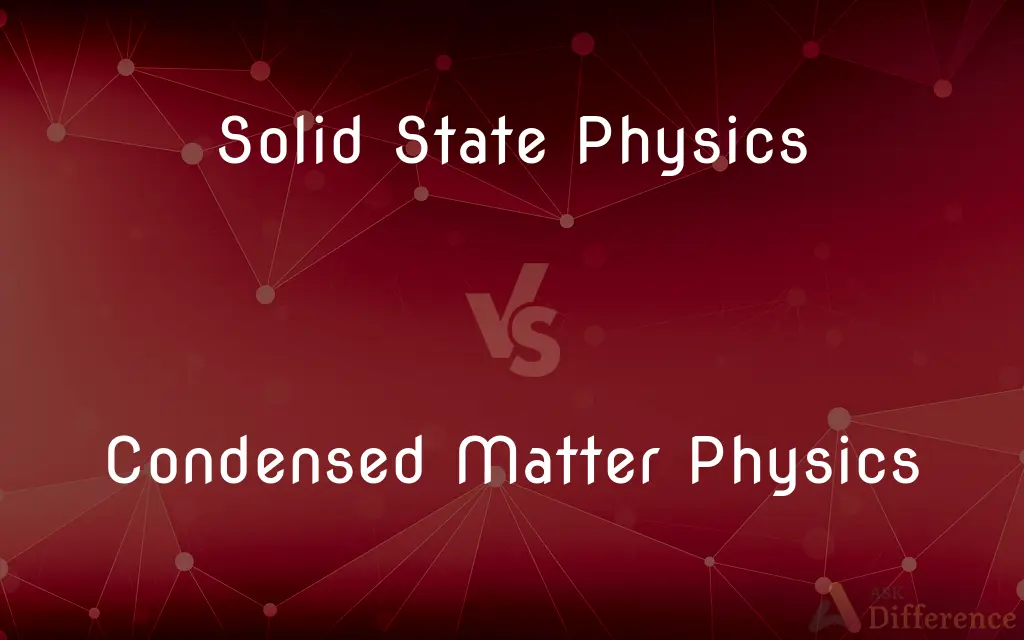Solid State Physics vs. Condensed Matter Physics — What's the Difference?
By Fiza Rafique & Maham Liaqat — Published on May 17, 2024
Solid State Physics focuses on properties of solid materials, particularly crystalline structures, whereas Condensed Matter Physics covers solids and liquids, emphasizing phases and phenomena at macro and microscopic levels.

Difference Between Solid State Physics and Condensed Matter Physics
Table of Contents
ADVERTISEMENT
Key Differences
Solid State Physics is primarily concerned with the study of crystalline solids and their electronic, optical, and mechanical properties. It delves into the behavior of electrons within these materials, which is crucial for understanding semiconductors, metals, and insulators. On the other hand, Condensed Matter Physics expands the scope to include not just solids but also liquids and other phases of matter. It examines how matter's various states arise from interactions between particles, leading to a broader range of phenomena like superconductivity and magnetism.
While Solid State Physics often focuses on the implications of band theory and the role of lattice structures in determining material properties, Condensed Matter Physics takes a more inclusive approach. It explores quantum mechanics' effects on a wide range of materials, including soft condensed matter like polymers and biological systems. Whereas the former might concentrate on the specific properties of crystals, such as electron mobility and band gaps, the latter investigates the universal principles governing phase transitions and critical phenomena.
In Solid State Physics, the emphasis is on understanding how imperfections in a solid's crystal lattice, such as vacancies and dislocations, affect its properties. This knowledge is vital for designing and improving materials for electronic devices. Conversely, Condensed Matter Physics looks at both ordered and disordered systems, including the study of amorphous solids and glasses, where disorder plays a crucial role in determining material properties.
Solid State Physics has historically paved the way for developing semiconductor technology and various electronic components, highlighting its focus on applied research. In contrast, Condensed Matter Physics, while also contributing to technological advancements, often ventures into more theoretical realms. It seeks to understand the fundamental principles that govern all forms of condensed matter, leading to discoveries like quantum Hall effects and topological insulators.
Though both fields study matter's physical properties, Solid State Physics tends to use theoretical models based on perfect crystalline structures to explain phenomena. Meanwhile, Condensed Matter Physics embraces complexity and imperfection, applying statistical mechanics to understand the behavior of systems with a large number of interacting constituents, bridging the gap between idealized models and real-world materials.
ADVERTISEMENT
Comparison Chart
Focus
Crystalline solids
Solids and liquids, including soft matter
Core Interest
Electronic, optical, and mechanical properties of solids
Phases and phenomena across all condensed matter
Theoretical Foundation
Band theory, crystal lattice imperfections
Quantum mechanics, statistical mechanics
Materials Studied
Metals, semiconductors, insulators
Includes polymers, biological systems, amorphous solids
Applications
Semiconductor technology, electronic devices
Technological advancements, theoretical and practical devices
Compare with Definitions
Solid State Physics
Focuses on crystal lattices and their imperfections.
Analyzing the impact of doping on silicon's electrical properties.
Condensed Matter Physics
Applies principles of quantum field theory to condensed matter.
Exploring topological insulators for quantum computing.
Solid State Physics
Studies the properties of solid materials, especially their electronic and crystal structure.
Exploring the conductivity of a semiconductor.
Condensed Matter Physics
Explores phenomena like superconductivity and magnetism.
Investigating the properties of high-temperature superconductors.
Solid State Physics
Applies quantum mechanics to explain electron behavior in solids.
Understanding band gaps in semiconductors for electronic applications.
Condensed Matter Physics
Aims to understand the fundamental principles governing matter's behavior.
Studying phase transitions in magnetic materials.
Solid State Physics
Investigates phonons and their role in heat capacity.
Examining how vibrations in a crystal lattice influence thermal conductivity.
Condensed Matter Physics
Covers both solid and liquid states of matter, studying complex interactions.
Researching superfluidity in helium.
Solid State Physics
Relates to the development of electronic and optical devices.
Designing LEDs based on the principles of solid state physics.
Condensed Matter Physics
Includes the study of soft condensed matter like polymers.
Analyzing the elasticity of polymer networks.
Common Curiosities
Can Condensed Matter Physics apply to biological systems?
Yes, it includes the study of biological materials as part of soft condensed matter research.
What is Solid State Physics?
It's the study of physical properties of solid materials, focusing on crystals and their electronic structures.
What are some applications of Solid State Physics?
It's crucial for developing semiconductors, electronic devices, and optical systems.
Why is the study of crystal lattice imperfections important?
Imperfections affect material properties, influencing the performance of electronic components.
What is a common subject studied in both fields?
Both study superconductivity, though from different material perspectives.
What is the significance of statistical mechanics in Condensed Matter Physics?
It helps understand the macroscopic properties of materials from microscopic particle interactions.
What role does quantum mechanics play in these fields?
It provides the theoretical foundation for understanding particle interactions in materials.
How does Condensed Matter Physics differ from Solid State Physics?
Condensed Matter Physics covers a broader range of materials, including solids and liquids, and focuses on universal physical principles.
How are theoretical models used differently in these fields?
Solid State Physics often relies on models based on perfect crystals, while Condensed Matter Physics incorporates more complexity and disorder.
How does band theory apply to these fields?
Band theory explains electronic properties in solids, crucial for both fields but emphasized in Solid State Physics.
How do Solid State and Condensed Matter Physics contribute to technology?
Both fields lead to technological advancements, though Solid State Physics focuses more on electronic applications.
Are polymers considered in Solid State Physics?
Typically, polymers fall under Condensed Matter Physics due to their soft matter characteristics.
What distinguishes the materials studied in Solid State Physics?
It mainly focuses on hard, crystalline materials like metals and semiconductors.
Is the study of heat capacity different in these fields?
Both study heat capacity, but the focus and materials may vary, with Condensed Matter Physics covering a wider range.
Can Condensed Matter Physics predict new states of matter?
Yes, it's instrumental in predicting and discovering new matter phases, like topological states.
Share Your Discovery

Previous Comparison
Arm Roast vs. Chuck Roast
Next Comparison
Trolleys vs. TrolliesAuthor Spotlight
Written by
Fiza RafiqueFiza Rafique is a skilled content writer at AskDifference.com, where she meticulously refines and enhances written pieces. Drawing from her vast editorial expertise, Fiza ensures clarity, accuracy, and precision in every article. Passionate about language, she continually seeks to elevate the quality of content for readers worldwide.
Co-written by
Maham Liaqat












































